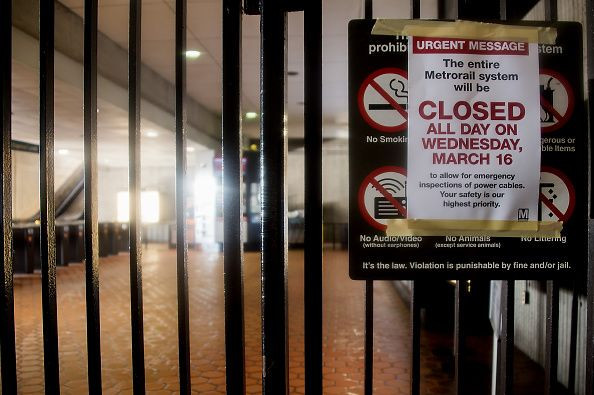Washington, DC, Metro To Reopen Thursday After Safety Shutdown

Washington, D.C.'s subway system will reopen on Thursday after a day-long shutdown for emergency safety checks that forced commuters to battle heavy traffic aboard crowded buses, on bicycles and even skateboards.
Washington's Metrorail, the second-busiest U.S. subway system, will reopen at 5 a.m. EDT after crews wrap up checks of power cables, Paul Wiedefeld, general manager of the Washington Metropolitan Area Transit Authority, said on Wednesday.
He told a news conference that some of the 91 stations on the 119-mile (190-km) system may remain closed if repairs were not finished by the scheduled reopening time.
"Our intention is to finish them in the evening," Wiedefeld said. He added that 26 defective cables had been found and 18 had been repaired.
The shutdown of Metrorail at midnight on Tuesday prompted many of the estimated 700,000 people who ride the system on a typical weekday to complain that they had little time to prepare before it was announced on Tuesday afternoon. The shuttering was intended to give safety crews time to inspect 600 underground cables that could pose a fire risk.
The shutdown also raised concerns about the safety of a system serving the U.S. capital and its Maryland and Virginia suburbs that has long been plagued by smoky tunnels, breakdowns and deadly accidents. It was the first time the system had been closed for something other than bad weather since it started operating in the 1970s.
The closure was no windfall for the city's cab drivers, many of whom said the heavy traffic was hurting their business.
Rayna Smith, 30, said it was standing room only on the bus she took to work at the Council of the District of Columbia, unusual on a route where she normally finds a seat.
"It was jam-packed," Smith said. "But it was also pretty quiet, no one was really talking ... I guess we were all just suffering in silence."
U.S. government offices, Congress and most schools remained open, although the Office of Personnel Management, which oversees the federal workforce, gave employees the option of taking unscheduled leave or working from home.
U.S. Transportation Secretary Anthony Foxx said the shutdown was necessary for a system where 18 people have been killed in rail accidents in the past 34 years.
"WMATA has a long, well-documented list of safety issues and needs to work aggressively to fix them," Foxx said in a statement. "While this shutdown is inconvenient, they are doing the right thing by putting the safety of their passengers and workers first."
POOR INFRASTRUCTURE
Ted Cox, a 62-year-old immigration lawyer from New York, was among the many people who complained about crumbling infrastructure and gridlock stemming from the untimely subway shutdown.
"What kind of country are we in, that the nation's capital can't run a metro system?" he said. "It's sort of on a par with the infrastructure in the rest of the country. Hopefully this will get the attention of legislators to deal with infrastructure in general."
Cab drivers said traffic limited the number of trips they could take.
"Everywhere is crowded," said Asamenew Tesfaye as he drove a yellow cab in from suburban Alexandria, Virginia. "It looks busy for everybody, but we make less money than the other days."
Some commuters took to Twitter to express frustration at delays and crowding on buses, making #MetroShutdown the top-trending hashtag in the United States on Wednesday morning.
One user joked that the city should flood the subway tunnels to the level of the platforms and rely on Venetian gondolas rather than trains.
Ride service Uber [UBER.UL] said it would cap surge pricing in the Washington area at 3.9 times base fares during the shutdown. San Francisco-based rival Lyft, meanwhile, said it was offering new customers $20 off their first ride.
Some commuters found more creative solutions to their transport woes. Brendan Norwood-Pearson, a 20-year-old junior at American University, said he was in class in the morning when he realized the subway shutdown could leave him late for work at the Smithsonian National Air and Space Museum.
His best option, he decided, was the skateboard he navigated at a blistering pace alongside the National Mall.
"The buses take too long to get down here," Norwood-Pearson said. "A skateboard takes 35 minutes to get down here and in a bus it's an hour."
© Copyright Thomson Reuters 2024. All rights reserved.





















